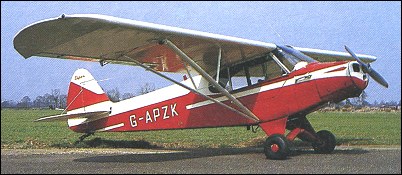|
| Certainly the most famous product of the Piper Company, the original version of the Piper PA-18 Super Cub,
powered by a 67kW Continental C90-12F flat-four engine, first came on the market in late 1949 after gaining type certification on 18 November 1949. It continued in production with Piper until 1981, when the company disposed of all rights in this aircraft to WTA Inc. of Lubbock, Texas. In the intervening period the PA-18 had appeared in progressively improving form, and had been powered by a variety of engines rated between 67 to 112kW. In its final Piper production form, as the PA-18-150, its basic configuration was that of the earliest two-seat Cubs with braced high-set wings, wire-braced tail unit, and fixed tailwheel landing gear, but powered by a 112kW Avco Lycoming O-320 flat-four engine. This powerplant had been used also for a specialised agricultural duster/sprayer version designated PA-18A which had been introduced in 1952; it incorporated as standard a chemical hopper and spray/dusting gear, but was easily convertible for general-purpose use, and when production ended a total of 2,650 had been built. In addition to civil construction, Piper built 838 PA-18s with the 71kW Continental C90-8F engine for the US Army under the designation L-18C, 108 of this total being supplied to foreign nations under the Military Aid Program, and the army then ordered 150 examples of the generally similar L-21A which differed by having the 92kW Avco Lycoming O-290-II engine; at a later date a number of these aircraft were converted for use as trainers, then being redesignated TL-21A. Under the designation YL-21 the US Army evaluated two examples of a version of the PA-18 Cub powered by a 101kW Avco Lycoming O-290-D2 engine, later acquiring a total of 584 under the designation L-21B, a number of them being supplied to foreign nations under MAP. In 1962 in-service L-21Bs were redesignated U-7A.
| MODEL | Piper PA-18-150 Super Cub |
| ENGINE | 1 x Avco Lycoming O-320 fiat-four piston engine, 112kW |
| WEIGHTS |
| Take-off weight | 794 kg | 1750 lb |
| Empty weight | 446 kg | 983 lb |
| DIMENSIONS |
| Wingspan | 10.73 m | 35 ft 2 in |
| Length | 6.88 m | 23 ft 7 in |
| Height | 2.04 m | 7 ft 8 in |
| Wing area | 16.58 m2 | 178.47 sq ft |
| PERFORMANCE |
| Max. speed | 209 km/h | 130 mph |
| Ceiling | 5790 m | 19000 ft |
| Range | 740 km | 460 miles |
| Wayne Grant, e-mail, 12.10.2010 17:14 I soloed and got my first 40 hours in a PA 18 back in 1965. I'm into radio controlled airplanes now and the Super Cub is high on my list to build and fly. reply | | John P Courte, e-mail, 27.09.2010 14:59 I learned to fly in this aricraft and I am convinced that if you can fly the super-cub, you can learn to fly anything, both fixed and rotary. Great airplane. reply | | Scott Boyd, e-mail, 05.06.2010 05:20 When I was in college in Gunnison Colorado I flew numerous newer Supercubs and what we called the Unsupercub, an older military version with a glass, or plexiglass top and a 135hp engine, the Supercubs were pretty new and had 150hp engines.
They actually worked pretty good in the high mountains but when we got Bird Dogs they didn't get used too much for searches but were cheap to use for personal use, which we could do.
When I was flying charter we had a PA-12 that was pretty much a toy. I overhauled the engine in my BMW and took the head to Durango to get it milled, other then stuff like that it got little use. reply | | Bob Leonard, e-mail, 19.08.2010 22:17 I love the PA-18 on floats. It is a real neat proformer, getting in and out of small "pot-holes" in the flat lands of Alaska. No pilot ever over-loads his aircraft....but...all I can say is that the Super Cub will carry a load! If it will get up on the step, it will fly! If not, taxi back and off load a few pounds and try again.
Verne (comment below) is 100% correct regarding cross control in steep turns. We lost a well known Guide in Alaska as he was flying steep circles around a Moose. But, we all know, 'any' aircraft can kill you if you give it the chance. reply | |
| | Verne Lietz, e-mail, 28.01.2010 05:43 Had a well-used (almost junker) 1952 model, then a 1957, flew both to Alaska eventually. Also from Wenatchee, WA to Durham, NC, and back with no radios. Our son was 10 years old on one Alaska flight and made two take-offs and two landings without any comment or control input by me. He now flies Boeing 767s, 757s and 737s for USAirways. The Super Cub is great for rugged flying in the wilds or mountains as long as the pilot doesn't cross control in steep turns at low altitude....then it's a killer. reply | | Sam Herron, e-mail, 03.12.2009 02:20 I flew this aircraft for 20:10 hours at Columbus AFB in Class 54-0, soloed and got a check ride before moving to the T-6. Was penalized by 10 minutes in the T-6 for over-flying the alloted 20:00 hours in the PA-18. reply | | Andre Barros, e-mail, 19.02.2007 13:37 I want to know the cruise speed of the PA 18 with the Lycoming 180 hp engine.
Thanks reply |
|
Do you have any comments?
|
| 
COMPANY
PROFILE
All the World's Rotorcraft
|






